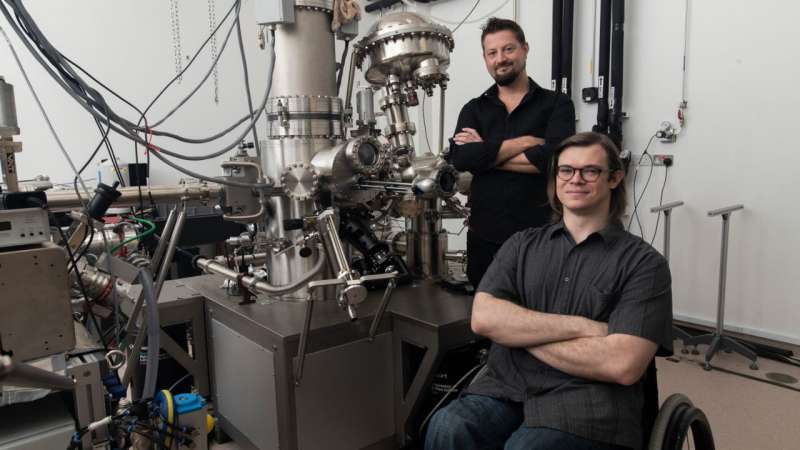Electrons on the edge: Atomically thin quantum spin hall materials

Quantum spin Hall insulators are a class of two-dimensional (2D) topological states of matter that are electrically insulating in their interior but, unlike semiconductors, carry a pair of one-dimensional (1D) metallic states, which are strictly confined to their edges.
Particular to these 'edgy' 1D electrons is that they are what physicists call helical: ie, the spins of conduction electrons are aligned and tied to the direction that electrons move along the 1D edge, akin to a pair of spin-polarized one-dimensional wires. These helical properties offer potential solutions for problems in electronics and spintronics, as well as quantum electronic devices.
Just as a sheet of paper maintains its two sides even when crumpled, the physical properties of the metallic edge states of a quantum spin Hall insulator are remarkably stable against perturbations—they are protected by topology.
First theoretically predicted two decades ago, this exotic, topological state of matter first realized in carefully designed, layered semiconductor heterostructures.
More recently, classes of atomically thin crystals are emerging, similar to the famous graphene, which host this electronic state of matter as an intrinsic property.
In their article in Advanced Materials in April 2021 (link below), the team reviews recent advances in materials engineering alongside the theoretical description, surveying the library of promising atomically thin quantum spin Hall insulators with view on classical and quantum electronic device applications.
For example, the temperature range over which the exotic edge states can be harnessed scales with the properties of these crystals, such as the coupling strength of the electron's spin to its orbital momentum.
While semiconductor heterostructure-based quantum spin Hall insulators have only been characterized at liquid helium temperatures (T < 4.2 K), recent progress has seen the development of atomically thin crystals which retain their quantum spin Hall properties up to 100 K, promising room-temperature demonstrations in the future.
Quantum spin Hall insulators could be used for new kinds of electronics that consume less power, but this would require room-temperature operation to avoid costly (and power-hungry) cooling.
At the extremes of low temperature where superconductivity can be induced, especially promising quantum-computing applications have been predicted. When superconducting, the 1D edge states have been predicted to host an exotic type of quasiparticle called "Majorana fermions," which is neither fermion nor boson. Indeed, these anyons act as their own antiparticle and obey exotic non-Abelian quasiparticle statistics which makes them exciting candidates as carriers of quantum information.
Indeed, owing to their topological protection against external disturbances, these exotic fermions have been predicted to offer a potential solution to a common problem in quantum computation, which is to retain long coherence times—ie, the timescale over which quantum information can be stored and processed.
Majorana-based topological quantum computing are often regarded as one of the most challenging physical problems of our time. It has received immense media attention and scrutiny, especially recently, highlighting the importance for continuing research into alternative materials and device platforms in which topological quantum computing can be realized.
The paper, Atomically Thin Quantum Spin Hall Insulators (Michael S. Lodge, Shengyuan A. Yang, Shantanu Mukherjee, and Bent Weber) was published in Advanced Materials in April 2021.
More information: Michael S. Lodge et al, Atomically Thin Quantum Spin Hall Insulators, Advanced Materials (2021). DOI: 10.1002/adma.202008029
Journal information: Advanced Materials
Provided by FLEET




















